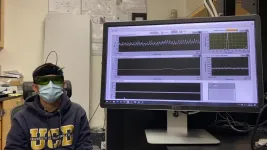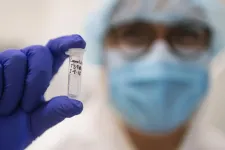(Press-News.org) The quest to create safer, more successful pregnancies is one of the top goals of modern science. While pregnancy is better understood today than ever before, with improvements in technology helping to lower the risk of negative outcomes, there is much researchers still don't know about a vital part of the pregnancy process: uterine fluid.
Secreted by glands in the uterus during pregnancy, uterine fluid is believed to play an important role in supporting a developing embryo by sending information from the uterus to the embryo, along with a host of other speculated functions. But studying this fluid in women presents myriad dilemmas, given that studies might require invasive monitoring or experimentation during an active pregnancy.
Now, in a new study published in the Proceedings of the National Academy of Sciences (PNAS), researchers at the University of Missouri have found a way to study uterine fluid in the lab, thereby avoiding invasive procedures during pregnancy, while at the same time developing a potential model for using precision medicine to improve pregnancy outcomes.
"Using stem cell-derived organoids, we were able to isolate an analogue to uterine fluid in the lab," said Constantine Simintiras, a postdoctoral research fellow in the College of Agriculture, Food and Natural Resources Division of Animal Sciences. "For such an understudied element of human pregnancy, being able to grow and study this fluid in the lab makes it much easier to advance our understanding of this important function of the uterus."
Working in National Academy of Sciences member Thomas Spencer's lab, Simintiras and his colleagues used "organoids" -- simplified versions of the tissue that forms the lining of the uterus, grown from stem cells -- as the source for a fluid that closely resembles uterine fluid. Inside the body, uterine glands secrete this fluid to support sperm migration and the early development of embryos.
Using organoids as a model not only sidesteps potential issues with extracting samples during pregnancy, but it also paves the way for a precision medicine approach to maintaining a healthy pregnancy. The hope is that by obtaining stem cells from expectant mothers, even before they conceive, researchers could study the composition of their uterine fluid to determine if any issues are present. For example, a deficit in NAD+ -- a "coenzyme" considered crucial for metabolism -- has been linked to birth defects and miscarriage.
"We know the composition of uterine fluid is extremely important, so we need to understand how that composition is regulated," Simintiras said. "In women it is likely influenced by hormones, but are there other factors at play? This model for lab study gives us a means to tackle such questions, and in the future, this could help us detect and correct problems with uterine fluid before they lead to complications."
INFORMATION:
The study, "Capture and metabolomic analysis of the human endometrial epithelial organoid secretome," was published in PNAS. Other MU researchers involved in the study were Thomas Spencer, Pramod Dhakal, Chaman Ranjit, Harriet C. Fitzgerald and Ahmed Z. Balboula.
In 2020, stores sold out of garden seed, coops and rabbit cages. Now, we have an idea how much protein people can grow in their backyards.
The 2020 meat shortages led many to wonder what to eat for protein when supply chains are disrupted. Some people turned to gathering eggs, raising animals and growing their own food. A team from Michigan Technological University and the University of Alaska Fairbanks found that the work is well worth it. In a new study published in Sustainability, the researchers looked at how a typical household with a typical backyard can raise chickens, rabbits or soybeans to meet its protein needs.
People eat a lot of protein in the U.S. and the average person needs 51 grams of ...
MINNEAPOLIS/ST.PAUL (05/12/2021) -- In a study recently published in END ...
DURHAM, N.H.-- A national report from the University of New Hampshire shows close to one and a half million children each year visit a doctor, emergency room or medical facility as a result of an assault, abuse, crime or other form of violence. This is four times higher than previous estimates based only on data from U.S. emergency rooms for violence-related treatment.
In their END ...
A portable, rapid testing platform can detect gonorrhea infections in patient samples in under 15 minutes, far faster than standard-of-care tests that can take hours or days. The platform accurately detected infections and determined resistance to a common antibiotic in 217 patient samples from sexual health clinics in Baltimore and Uganda. The technology's speed and low cost could empower quicker and more affordable gonorrhea testing in low-resource regions, as well as help combat the spread of drug-resistant strains. Rates of gonorrhea and other sexually transmitted ...
A new, noninvasive method for measuring brain blood flow with light has been developed by biomedical engineers and neurologists at the University of California, Davis, and used to detect brain activation. The new method, functional interferometric diffusing wave spectroscopy, or fiDWS, promises to be cheaper than existing technology and could be used for assessing brain injuries, or in neuroscience research. The work is published May 12 in Science Advances.
"Now we can assess how well the brain regulates blood flow, and even detect brain activation noninvasively in adult humans, using principles similar to functional ...
MISSOULA - Only an anthropologist would treasure millennia-old human feces found in dry caves.
Just ask Dr. Meradeth Snow, a University of Montana researcher and co-chair of UM's Department of Anthropology. She is part of an international team, led by the Harvard Medical School-affiliated Joslin Diabetes Center, that used human "paleofeces" to discover that ancient people had far different microorganisms living in their guts than we do in modern times.
Snow said studying the gut microbes found in the ancient fecal material may offer clues to combat diseases like diabetes that afflict people living in today's industrialized societies.
"We ...
Researchers used genetic engineering tools to create a virus that can enter specific neurons and insert into the prefrontal cortex a new genetic code that induces the production of modified proteins. In tests with mice, the alteration of these proteins was sufficient to modify brain activity, indicating a potential biomarker for the diagnosis of psychiatric disorders such as schizophrenia and autism.
Sometimes referred to as the "executive brain", the prefrontal cortex is the region that governs higher-level cognitive functions and decision making. Studies of tissue from this brain region in patients with schizophrenia have detected alterations in two proteins: BDNF (brain-derived neurotrophic factor) and trkB (tyrosine receptor kinase B).
The relationship ...
A new study by the University of Georgia revealed that more college students change majors within the STEM pipeline than leave the career path of science, technology, engineering and mathematics altogether.
Funded by a National Institutes of Health grant and a National Science Foundation Postdoctoral Fellowship and done in collaboration with the University of Wisconsin, the study examined interviews, surveys and institutional data from 1,193 students at a U.S. midwestern university for more than six years to observe a single area of the STEM pipeline: biomedical fields of study.
Out of 921 students ...
UCLA life scientists have identified six "words" that specific immune cells use to call up immune defense genes -- an important step toward understanding the language the body uses to marshal responses to threats.
In addition, they discovered that the incorrect use of two of these words can activate the wrong genes, resulting in the autoimmune disease known as Sjögren's syndrome. The research, conducted in mice, END ...
A new study from North Carolina State University finds that greenhouse gas (GHG) emissions from standing dead trees in coastal wetland forests - colloquially called "tree farts" - need to be accounted for when assessing the environmental impact of so-called "ghost forests."
In the study, researchers compared the quantity and type of GHG emissions from dead tree snags to emissions from the soil. While snags did not release as much as the soils, they did increase GHG emissions of the overall ecosystem by about 25 percent. Researchers say the findings show snags are important for understanding the total environmental impact of the spread of dead trees in coastal wetlands, known as ghost forests, ...





